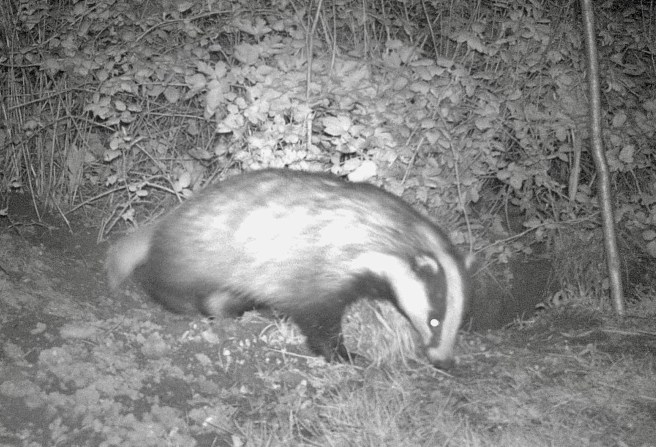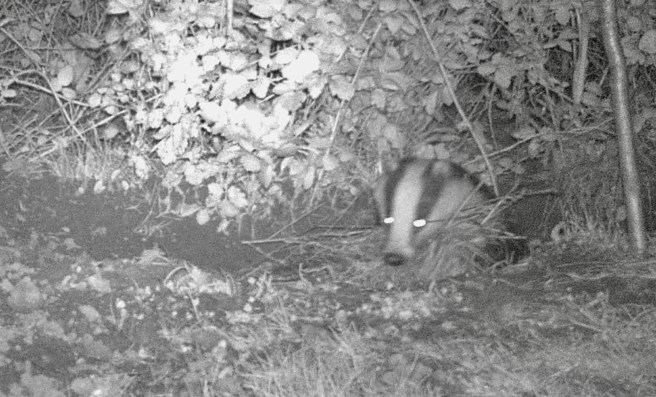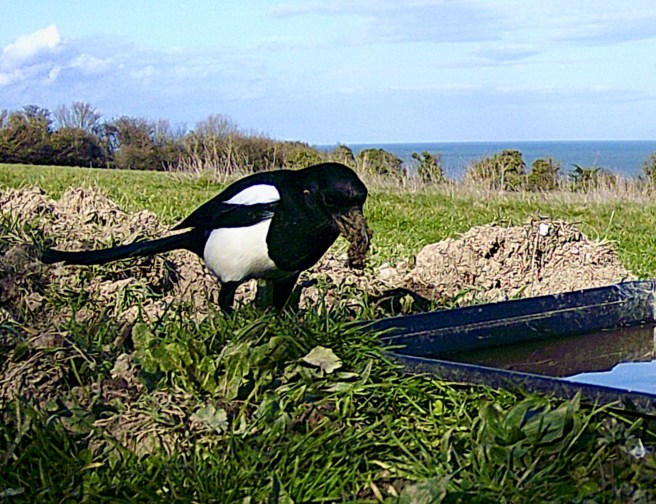British Summer Time is here at last, the hour has sprung forward and a whole extra section of the day becomes available to us for outside activities. The glorious prospect of summer evening dog walks and nature exploration lies ahead.
We are about to embark on our fourth year of being Red Mason Bee Guardians.
Each March we receive bee cocoons and cardboard nesting tubes from the guardianship scheme. We put these out into the meadows and the bees hatch and forage for pollen and then build their nests in cardboard tubes that we provide nearby. In September, once the bee larvae in the nests have transformed into hard cocoons to overwinter in, we send the tubes back to the Guardian scheme HQ for the cocoons to be extracted, cleaned of parasites and stored safely over winter.


In 2018, we sent back 45 used nest tubes, which contained a pleasing total of 342 healthy cocoons. This was an average of 7.6 cocoons per tube and a fantastic increase on the 25 cocoons we started with. In 2019, we proudly sent back 53 tubes, but only 184 viable cocoons were found within which is a disappointing 3.5 per tube. However, much, much worse was to come in 2020. Last year we managed a miserly 18 tubes which only contained 31 healthy cocoons – that’s a mere 1.7 cocoons per tube.
We don’t know what went wrong and why so few of the tubes were used and also why there were hardly any healthy cocoons within each tube. Perhaps parasites are building up in the area, attracted by all these bee nests and so we have decided to change the release site from the orchard to down by the wild pond and see how we get on in this new location. There are still plenty of pollen-rich flowers around there.


The mason bees need damp soil to build the walls between the nest cells and last year we discovered some bees taking their soil from deep in the badger tunnels. This new release site is much closer to the badger sett meaning that the bees won’t leave their nests unattended for so long when they collect the soil, giving less chance for parasites to attack.


It is so wonderful to have invertebrates around again and these days I am increasingly fascinated by them. I know not everyone is, although hopefully you will humour me if I include a couple here. We were lying in the grass looking closely at a patch of Sweet Violets that were surprisingly pale-coloured – all the others here are a deep purple:

While we were down there, close to the soil, we noticed this tiny little chap that looks straight out of a Disney cartoon to me:

This is a nymph of a Leafhopper (in the sub-family Deltocephalinae – possibly Euscelis incisus).
This next small bug, that I found sunbathing on a leaf, has a lovely white heart on its back. It is a Mirid bug, possibly Lygus pratensis, but there are many that look similar. It will be sucking sap from plants.


I was very pleased to get this photo of a Whirligig (Gyrinus sp). These tiny beetles gyrate madly in circles on the surface of the ponds and represent a real photographic challenge. The breakthrough came when I realised that they slowed down, and sometimes even actually stopped, when I wasn’t looming over them. So it was simply a question of pretending I had gone away, whilst still lurking close by.

We have seen another Peacock that has suffered from the ravages of time. This one has most of a forewing gone:

Good to see that the Slow Worms are starting to appear under the reptile sampling squares:

A month after the frogspawn was laid in the wild pond, an additional blob has appeared in ludicrously shallow water. We have moved it somewhere a bit deeper and less likely to dry up before the tadpoles are grown.

The Badgers have been taking bedding down the hole that opens directly into the meadows, suggesting that the baby Badgers are down there:



A few years ago we went to Costa Rica and were astounded to see the Resplendent Quetzel:

Sometimes, when the light hits the tail of a Magpie at just the right angle, it brings a little bit of Costa Rica to the meadows:

Magpies are still nest building. I have so many photos of them taking beakfuls of wet earth from next to the little pond on the strip, where the soil is kept damp by the splashing of bathing birds :



Slightly out of focus, but great to see a pair of Green Finch:

Why this is so great is because they are having an absolutely terrible time at the moment, the population being devastated by a parasite of the oesophagus, Trichomonosis. Transmission is most likely through contaminated food and water – a major incentive to keep feeders regularly washed. This disease was first noticed in Greenfinch in late summer 2006 and, although birds’ current conservation status is green, being of least concern, this will surely now change when this is next reviewed.

If I hadn’t already managed to read the ring code of the colour-ringed Herring Gull, GR94467, I definitely would have done so by now:


I am working under the assumption that she is a female and, together with her mate, they have become regulars up on the strip. They are magnificent-looking birds and I am now very fond of them both:



There continue to be a number of Yellowhammer here – I think it could even be described as a small flock. I count nine in this photo, along with a House Sparrow.


A few Linnet about:

And a Starling or two:

Blackbirds have started nest building in the same vicinity as last year. It is the female who does all the work:

Although the male has found a caterpillar:

Sparrowhawk:

Moving inland to the wood now, the Tawny Owl has been worming again in the usual spot.

We haven’t seen it successfully catch a worm this winter, but we got this photo last year:

Blackbirds are building nests in the wood as well:


We don’t see Bullfinch in the wood during the winter but a pair have bred both summers we have been here. So its great to see them back:

Some other photos from the wood:





Finally, back in the meadows, I’m keeping my eye very firmly on this beautiful and delicate vixen:

I am very suspicious of what’s going on with her tail and suspect the beginnings of mange. Watching the foxes here over the years has taught me how quickly this spreads once it gets a hold and I want to act fast if necessary. Here is her tail from a different angle and there is a definite bald patch halfway along:

If I need to start dispensing the medicine-laced honey sandwiches again, I think she would be an easy target because I see her at the peanuts most nights. However, the issue will be how to stop the old gentleman fox from eating them all before she arrives. Here he is, needing to have a stretch after waiting for an hour for me to arrive. He is always first on the scene.

But that is a problem for the future. Although I do not yet have a photo, I have seen that the one-eyed vixen is now looking slim again – she has had her cubs. I am so looking forward to seeing the badger cubs and then the fox cubs on the cameras in the next few weeks.

Cool stuff That’s a beautiful magpie. I also have never seen a sparrowhawk, so this was really cool.
That Mirrid bug is so cute with the heart on its back. Good luck with the lady fox and keeping the old gent away whilst you feed her.